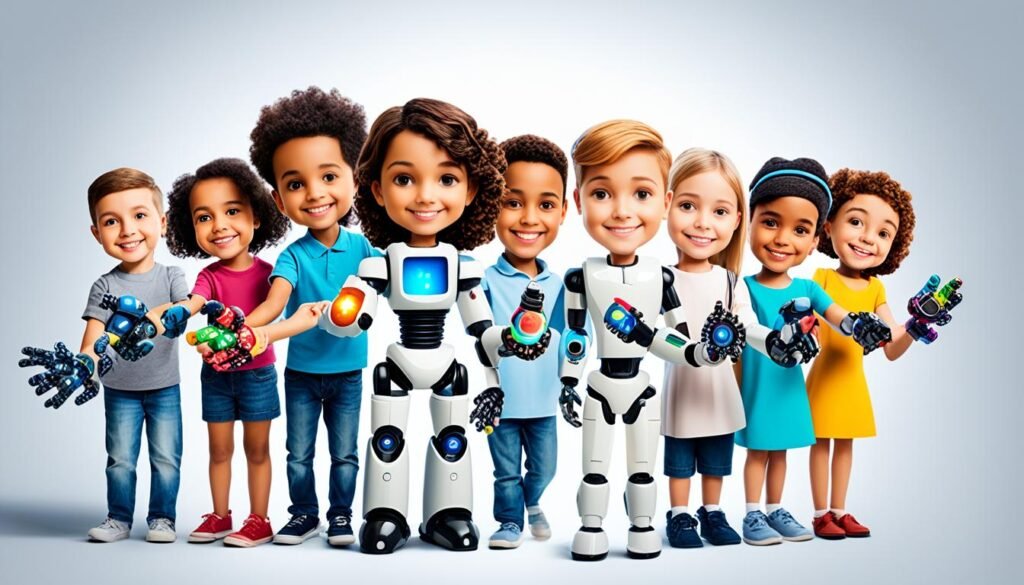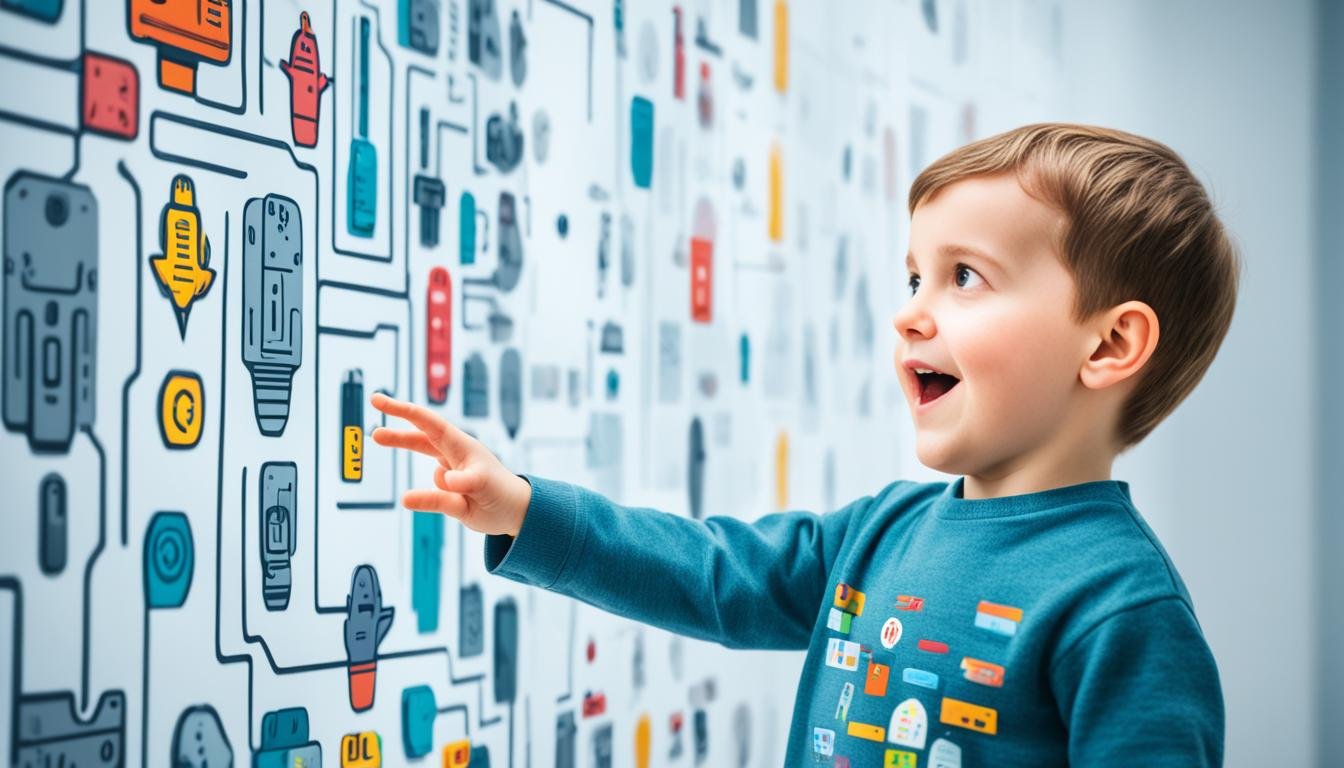Did you know that 81% of parents let their kids watch YouTube videos? As AI becomes a big part of kids’ lives, teaching them about AI ethics is key. This article will show how to talk to kids about AI ethics. It aims to improve their digital literacy and critical thinking.
By learning about AI’s human roots, how it uses data, and its biases and privacy issues, kids can see AI’s role in their lives. This knowledge helps them be smart digital citizens. They’ll help shape AI’s future, which will greatly affect their generation and others.
Key Takeaways
- Importance of teaching AI ethics to children in an age of increasing AI integration in their daily lives
- Understanding the human-centric nature of AI and the need to address biases and ethical considerations
- Fostering digital literacy and critical thinking skills to navigate the evolving technological landscape
- Empowering children to become responsible digital citizens and shape the ethical development of AI
- Preparing children for future careers and roles in the AI-driven world
Understanding AI’s Human Origins
When kids start to learn about artificial intelligence (AI), it’s key they know it’s made by humans. Tools like Alexa, Google Home, and educational apps aren’t magic. They’re the result of human creativity and computer skills. Knowing this helps kids see AI as something made by people, just like us.
AI Systems Are Developed by Humans
It’s important for kids to understand AI isn’t a magic box. It’s made by people like computer scientists and engineers. They give AI certain tasks and features. Kids should know that the rules, data, and choices AI makes come from the humans who create it.
Recognizing Human Biases in AI
Kids learning about AI should also know it can reflect human biases. Things like gender, race, and age can affect the data used to train AI. This can lead to unfair results. It’s vital to work on making AI fair and diverse for ai ethics for kids and responsible ai for kids.
| Key Insights | Implications for Children |
|---|---|
| AI is created by humans, not magical entities. | Children should understand the human origins of AI to recognize its limitations and potential biases. |
| Human biases can be reflected in AI systems. | Children should learn to identify and address biases in AI to promote ethical ai principles for kids and ai values for youth. |
“Addressing biases and ensuring diverse perspectives in AI development is an essential aspect of teaching AI ethics to children.”
The Importance of ai ethics for kids
As responsible AI for kids and youth AI literacy grow in importance, it’s key to teach young people about AI systems. By talking to kids about ethical AI principles for kids, we help them make smart choices with technology. This way, they can use AI wisely.
Teaching kids’ AI education is about more than just training future AI experts. It’s also about making sure people know how to use technology wisely. AI values for youth should be taught early to make sure technology helps everyone, not just a few.
- Studies say AI ethics should be taught in schools to kids 11 and younger.
- With AI in our daily lives, like in virtual assistants and social media, it’s key to teach kids about its effects and risks.
- It’s important to have lessons on AI ethics that fit the age, just like teaching about sex and drugs.
Learning about responsible AI for kids helps the next generation use technology with confidence and honesty. This way of teaching ethical AI principles for kids is vital for our future.
| Statistic | Implication |
|---|---|
| AI ethics is argued to be as fundamental for children in elementary school as sex or drug education. | Shows the need to start teaching AI ethics early, along with other important life skills. |
| Research suggests that AI ethics should be mandatory in schools teaching children ages 11 and under. | Points out how important AI ethics education is for young kids. |
| ChatGPT’s accuracy rate in answering a simple math problem dropped from 98% to 2% over just a few months. | Shows how fast AI technology changes and why we need to think critically about its trustworthiness. |
| An AI image generator predominantly depicted light-skinned people in high-paying jobs and dark-skinned people in low-paying jobs. | Highlights how AI can reflect biases and why it’s key to teach kids to spot and fix these issues. |
By teaching kids about AI values for youth, we prepare a generation that can handle the digital world with care, empathy, and ethics. This effort in kids’ AI education helps both individuals and our society’s future.

AI’s Data-Driven “Intelligence”
To grasp AI’s amazing abilities, we must look at how it gets its vast knowledge. This comes from collecting data. The more data AI has, the better and more accurate it gets. But, this data often includes personal info, daily habits, and online actions of people, even kids. This brings up big worries about data privacy for children and how their data is used in AI.
Data Collection and Privacy Concerns
With AI in our lives more and more, teaching kids about their “digital footprint” is key. AI transparency for kids is vital in this data-driven AI world. Their every online move and action can be tracked and used to train AI.
Studies show we need strong rules to deal with the ethical sides of AI ethics for kids. Experts suggest a balanced way that lets AI help while keeping kids’ privacy and rights safe. Teaching kids how AI works and its risks helps them be smart digital users. This shapes the future of AI.
“The UN Committee on the Rights of the Child emphasizes the critical need for digital literacy to be integrated from pre-school and sustained throughout the educational journey.”
As AI touches more parts of our lives, teaching kids how to deal with it is key. By focusing on data privacy for children and AI transparency for kids, we protect their online tracks. This way, they can use AI in a responsible and right way.
Ethical Implications of AI Development
AI is becoming more common in our schools, and we need to think about its ethical sides. AI can pick up on the biases of its makers. If most AI creators are from one group, the AI might show biases like racism or sexism. Addressing bias and lack of diversity in making AI is very important.
Addressing Bias and Lack of Diversity
We need to make the AI development team more diverse by adding more women and people of color. Talking to kids about AI’s ethical sides helps them see why fairness and inclusion matter. This encourages them to join the AI field, making it more diverse and fair.
Still, many kids don’t have the tech they need for learning, with about 14% lacking it worldwide. Fixing this is key to making sure ethical AI principles for kids and AI fairness for children are followed. With AI in schools, we must focus on addressing bias in AI and making diversity in AI development a priority.
“By engaging children in discussions about the ethical implications of AI, we can help them understand the importance of promoting fairness and inclusion in the design and deployment of these technologies.”
Working together and using different skills, we can make AI that’s fair and good for all kids. This will help us use AI ethically and prepare the next generation to be responsible digital citizens.

Engaging Children in AI Ethics Discussions
As AI becomes a bigger part of our lives, it’s key to teach our kids about it. Topics like machine learning, bias, and privacy might seem hard, but we can explain them in a way kids can get. This helps them understand AI and make smart choices online.
The Algorithm Literacy project is all about this. It’s a partnership between KCJ and CCUNESCO. They use fun projects, guides, and videos to teach kids about AI ethics. This way, kids learn they’re smarter than AI and can control their online world. This helps build a future where AI is used ethically.
AI is becoming more common in schools, so we need to think about its ethics. There are big challenges, like not considering how kids develop, the role of guardians, and not enough focus on kids. Also, there’s no single plan for teaching AI ethics.
To fix this, we need more people involved, support for those making AI tools, and rules for accountability. We should also encourage working together across different fields. This way, we can make sure AI is fair, open, and safe for everyone. It should give all kids the chance to use technology without bias.
As we move forward with AI in schools, we must balance its benefits and risks. We need to talk to kids about these issues. This way, they’ll be smart and careful online users. They’ll help shape AI in a way that’s good for everyone.
Fostering Critical Thinking Skills
In today’s digital world, critical thinking is key for making sense of the vast info AI creates. Kids should learn to question and verify AI content. They should check facts against several trusted sources and spot biases.
Verifying Information from AI Sources
As AI gets smarter, it’s important for kids to check if the info they get is right. Encourage them to compare AI facts with sources checked by people. This way, they learn to verify AI information and will do well in life.
Using AI as a Learning Tool, Not a Final Answer
AI can be a great help in learning, but it shouldn’t replace thinking for themselves. Teach kids to use AI to start their research, not as the last word. This helps them grow into skilled thinkers ready for the digital world.
By teaching these habits, kids will know how to wisely use AI in their lives. They’ll make smart choices and help shape AI’s future responsibly.

“Developing critical thinking skills is crucial in the age of AI, as it empowers young people to navigate the digital landscape with discernment and creativity.”
Protecting Children’s Digital Footprints
In today’s digital world, keeping kids’ data safe is very important. They might not understand how their online actions affect them later. It’s key to teach them how AI uses their data for personalized content and ads. They should know the risks of sharing too much online.
Teach them about their “digital footprint” and how to check and change their privacy settings. This helps them control their online stories.
Did you know 77% of parents share their kids’ photos online? By 2030, this could lead to a lot of identity fraud, warns Barclays in the UK. By the time kids turn five, parents might have shared 1,500 photos of them online. It’s crucial to teach kids about the impact of their online presence.
In the US, kids help design AI systems, making up 34.7% of tech revenues in 2021. This shows how important it is for kids to know about the digital world they’re growing up in. The digital gap affects Black and Hispanic families more, showing we need to make digital skills available to everyone.
The Children’s Online Privacy Protection Act (COPPA) in the US protects kids under 13. The European Commission’s Better Internet for Kids (BIK+) strategy also aims to empower kids online. But, the Netherlands needs to improve in involving kids in AI decisions. We need a global effort to protect kids’ online tracks.
Teachers and parents should teach kids about their digital footprints. Talk about privacy, how to express themselves online, and respecting others. This way, kids can confidently navigate the digital world and protect their online identities.
“Teaching kids about digital footprints mirrors educating them on values like responsibility and truthfulness.”
Instead of just setting rules, have ongoing talks with kids about their digital footprints. This helps them make smart choices and manage their online life. It’s key to their privacy and future online.
Promoting Fairness and Inclusion in AI
AI is becoming more common in schools, so it’s key to make sure these technologies are fair and include everyone. AI can sometimes be biased, which can make things harder for some students. We need to make sure AI is made and used in a way that’s fair for all.
To do this, we should listen to different viewpoints and let kids help shape AI’s ethical rules. Kids have fresh ideas and experiences that can make AI better for everyone. By asking for their thoughts and getting them involved, we help them learn and make AI that’s good for all students.
Encouraging Diverse Perspectives
Kids bring unique insights and experiences to the table. By listening to them and talking about AI bias, we can make them part of the AI development process. This not only boosts their thinking skills but also makes AI better for all students, no matter their background or abilities.
The US Department of Education stresses the need for protecting data in AI systems. They suggest clear rules for how data is collected and used, secure data storage, and getting consent from parents and students. Teachers should make sure AI technology matches ethical values, aiming for a future where AI helps everyone.
| Statistic | Significance |
|---|---|
| 52 Instructional Design Capstones related to AI in Education | Shows how AI in education is getting more attention from scholars |
| 1950s: The decade when the term “artificial intelligence” was coined | Points out AI’s long history and growth |
| 1997: The year IBM’s Deep Blue computer defeated chess champion Gary Kasparov | Shows how AI has gotten better over time |
By valuing diverse views and ethical AI rules for kids, we can make AI fair for all children. This teamwork approach lets kids take charge of ethical tech, making the digital world more inclusive and fair for everyone.

Nurturing Lifelong Learning and Curiosity
In today’s fast-changing tech world, it’s key to teach kids to keep learning. Encouraging them to be curious and seek out new AI and tech knowledge prepares them for the future. Skills like adaptability, problem-solving, and critical thinking help them deal with change.
This way of learning helps kids grasp the changing world of ai ethics for kids. It also makes them innovative problem-solvers and future tech leaders. As teaching ai ethics to children grows in importance, a love for learning keeps them ahead and ready to make a difference.
Adding responsible ai for kids and ai values for youth to school programs deepens their understanding of AI ethics. Talking with kids about data privacy and the effects of AI helps them think critically about the digital world.
It’s not just about the tech side of kids’ ai education and youth ai literacy. It’s also about sparking their curiosity and adaptability. As technology changes, having these skills will help them succeed.
“Curiosity is the engine of achievement.” – Ken Robinson
By focusing on lifelong learning and curiosity, we prepare the next generation for an AI-driven future. They’ll face it with confidence, resilience, and a focus on ethical innovation.
Conclusion
As AI becomes more common in children’s lives, it’s key to teach them about its workings and ethics. Knowing how AI started, its data focus, and its ethical sides helps kids understand its role. This knowledge lets them see AI’s impact on their lives and the future.
By using discussions, projects, and promoting critical thinking, we can make kids more than just users of AI. They can help shape AI’s future in a responsible way. Teaching them about teaching ai ethics to children, responsible ai for kids, kids’ ai education, and youth ai literacy prepares them to use technology wisely. This leads to a fairer, more inclusive future for everyone.
The tech world faces big challenges with AI, like environmental and ethical issues. It’s vital to educate and empower our young people. By improving their critical thinking, checking AI info, and seeing AI as a tool, not the answer, we’re raising a generation ready for the AI revolution. They’ll have a strong moral compass to guide them.
FAQ
What are the key lessons children should learn about AI technology?
Kids need to know that AI is made by humans and can have the same flaws. They should grasp how AI uses data and the need to protect their privacy.
Why is it important to address bias and lack of diversity in AI development?
It’s key to fix bias and boost diversity in AI to avoid discriminatory tech. Talking with kids about this helps them see why fairness and inclusion matter in AI.
How can children develop critical thinking skills when interacting with AI-generated content?
Encourage kids to question and verify AI content with other sources. Teach them to use AI as a starting point, not the last word.
What is the importance of protecting children’s digital footprint?
Teach kids how AI uses their online data for personalization. Talk about digital footprints and privacy settings to help them manage their online presence.
How can we foster a mindset of lifelong learning and curiosity about AI and emerging technologies?
Encourage kids to keep exploring and asking about AI and new tech. Teach them skills like adaptability and critical thinking. This will help them succeed in a changing world.
